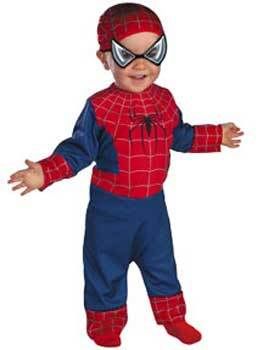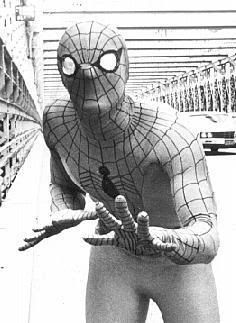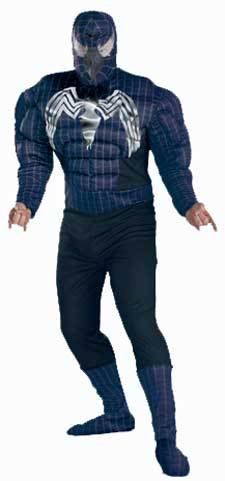Spider-Man yesterday.
Natural technology used by spiders and Gordon Gecko could help a human climb the side of a building, hang upside down from a roof, hold down a job at a local paper and fire webs from his wrists the analysis 'suggests'.
The findings/ramblings/lies are published in the Journal of Physics (incorporating Bullshite Monthly) this month.
Spiders possess tiny "hairs" (not in an exorcist way) that allow them to stick to surfaces and some studies suggest that Gecko can hold hundreds of times his own body weight (in hair gel).

Gecko: Greed is good (as are
weak intermolecular forces).
In 2002, US research suggested this adhesion in Gecko was due to very weak intermolecular forces produced by billions of hair-like structures of different sizes that are arranged in a hierarchical structure on each of Gecko's feet, or magic pixies.
The intermolecular "van der Waals" forces arise when unbalanced electrical charges around molecules attract one another or when the magic incantation is sung.
The cumulative attractive force of billions of gecko hairs allows the Wall Street character to scurry up walls, hang upside down on polished glass, shout 'Greed is good' a lot and use a brick sized 'mobile' phone.
Bespectacled yet attractive Professor Nicola Pugno, from STAR Labs, has calculated how sufficient salty stickiness (ooeerr) could be generated in the same way to support an adult human's body weight.
But the bigger the surface that needs to stick, the lower its adhesion strength. So a glove able to fit a man's hand, and covered with artificial gecko hairs, should not be as sticky as a gecko's foot (unless the man had giant hands obviously).
"Some researchers were able to measure a [theoretical] adhesion strength 200 times higher than the adhesion strength in the gecko. But between theory and practical applications there is a large gap," said Professor Pugno breathlessly as she took off her glasses and let down her luxuriant raven hair.
A spider last week.
"If we are able to make a surface a little bit stronger, so that the size effect vanishes, we might be able to make a suit with the same adhesion as Gecko's but without the braces, alternatively we could make a suit like the one Peter Parker wears. The problem with that is either Stan Lee will sue the arse of us and spend our research cash on wigs or it may end up looking like the one worn by Nicholas Hammond in the shite 70's TeeVee show."
The fictional science lab-based researcher proposes that carbon 'nanotubes' could be used as an artificial alternative to Gecko's hair (Carbon nanotubes are tiny cylinders of carbon that measure just a few billionths of a metre across. They are ultra-strong and can be organised into larger fibres for those thick shits reading).
Professor Pugno also outlined four properties which a real Spider-man suit must demonstrate.

A scientist tests the prototype.
Firstly, and most obviously, it must be red and blue with a web pattern and a spider emblem on the chest. Secondly, it must be able to demonstrate strong adhesive properties, the suit must be able to detach easily from a surface after it has stuck. Fourthly, the suit must, to some degree, be able to clean itself.
The latter requirement is considered important because dirt particles could get in the way, interfering with the adhesive properties of the suit or the dirt may manifest itself as an evil bio-entity, literally 'taking over the mind of the wearer making him become evil.
Dirt: Evil incarnate.
One way to do it is to make the suit "superhydrophobic", so that it strongly repels water. As water droplets are forced away from the contact areas of the outfit, they should wash away particles of dirt, easily achieved simply by altering the geometrical properties, or topology, of the surface.
"To have all these mechanisms working together is difficult, because they are in competition with one another," Professor Pugno us. Pobably.
"But geckos and spiders provide a natural demonstration that this can be done."
She added that there were many interesting applications for adhesive suits, in areas ranging from space exploration, window cleaning, fighting crime in New York to defence.
How the suit may look
if modeled by a lady.
But when we pointed out that human muscles are very different to those of spiders, so people would probably suffer from muscle fatigue if they tried to stick to a wall for many hours the Professor stormed off in a huff.
Crying.








No comments:
Post a Comment